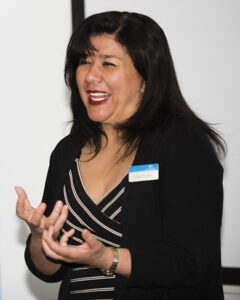Inspiring an audience to action: How to give a motivational presentation
4 October 2016
● News and media
Dr Zina O’Leary shares some of her research findings from her upcoming book Presentations that Motivate: Inspiring an Audience to Action.
We all know outstanding presentations and inspirational speakers when we hear them. We know because we are moved. We know because we want to tell others about it. We know because we feel inspired. Yet inspiring can be a difficult objective to reach.
Knowing how to influence an audience through an effective presentation is challenging. This is particularly true in an information age in which Google and Wikipedia hold knowledge that was once the domain of experts. This means our communication needs to do more than inform. It still needs to deliver content, data, and evidence, but it also needs to make an impact, to be influential.

In the public sector, for example, there is always an initiative, project, program, or policy reform that needs to be championed. Advocacy is essential and presentations that fail to motivate can end the run of a potentially good innovation. Improved presentations can lead to a more engaged debate on key public administration issues, and contribute to continuing reform in the public sector.
So how do we make our presentations more persuasive, more powerful, and more likely to motivate action? What is best practice when it comes to credible and influential communication?
Looking at 70 of the best, most inspired presentations of the past decade, I deconstructed the elements that underlie truly inspirational presentations. Once best practice was identified it was then compared to a cross section of presentations delivered in the Australia and New Zealand public sector. Identified gaps were then explored for their ability to inform teaching strategies.
What does a motivational presentation look and sound like?
Through my research I came up with a list of core elements that make a highly effective and motivational presentation. What I discovered was both introverted and extrovert personalities can deliver presentations that motivate and it doesn’t come down to just one or two particular styles or killer PowerPoint slides. The most effective presenters consider their audience, are knowledgeable on the topic, and know how to bring out their best self and tell a story. Here are five of my top findings to help you take your presentation skills to the next level.
1. You do not need to tell everything you know!
Without a doubt you need to know your stuff; you do not have a right to present, if you don’t know what you are talking about. Knowing your stuff gives you credibility and confidence. But here is the kicker: you do not need to tell them everything you know! Let your knowledge be obvious. Let it be obvious by showing that you can extract essential, compelling elements; by your confidence; by your flexibility. This is not about your ego. This is not about showing people how much you know. This is about your audience and what they walk away with.
2. Think about what you want your audience to achieve
You will undoubtedly have an objective related to your presentation. Stop and think about what you want your audience to achieve. Is your goal for your audience to know all the ins and outs of a particular initiative? Or could it also be that you want them to be shocked, be motivated, be willing to change behaviours, be willing to get on board, be a change agent? I think these are the things that matter when we are presenting – and the things we often forget. But if you can articulate this type of audience-related goal, it will change how you structure and deliver your presentation. You have no choice but to go from reporting to motivating.
3. Tell a story
Without a doubt the best presenters know how to tell a story. They tell a tale, they build anticipation, they shoot for ‘aha’ moments, they use anecdotes, and they are not afraid of weaving in appropriate bits of emotion. Your vocal performance is very important and one of the best ways to make your voice ‘sing’ is through story telling.
4. Make the audio-visuals work for you
Audio-visual aids should support you, not replace you. If you are using PowerPoint, go for the minimum. I recommend no more than one slide for every 2 minutes on stage – fewer if possible. Also try to move away from text-based slides to more powerful visuals. Think about video as well – Internet streaming is not as problematic as it once was. Also think about animating yourself. I always use a lapel microphone and a wireless mouse so that I can move around and draw focus. Hiding behind a podium is less likely to be engaging.
5. The power of you
Here is a fact. People are motivated by people. Compare your favourite university lecture-based subject with your most hated. I bet that content is only a minor pla{loadmodule mod_custom_banner,Banner Alumni – quote}yer in that differentiation. It is the lecturer who motivates and inspires. And that means you count. Your presentation needs to have your stamp on it; you need to ‘show up’. Now that doesn’t mean you should try to be funny if you’re not (that will flop!) or try to be authoritative if you’re shy (that will only make you more nervous), but do bring out your unique brand of warmth. I recommend thinking about what your best friend, partner or parents would say is your best quality – authoritativeness, sincerity, humour, warmth, wisdom. I then challenge you to present in a way such that your audience can see that quality reflected in the presentation.
Dr Zina O’Leary is a senior lecturer at the University of Sydney and ANZSOG. A sociologist by training, Zina has taught communication courses in the US, Australia, Hong Kong, Fiji and Malaysia and her subjects emphasise research design, evidence for decision-making and effective communication.
Zina’s two-day executive workshop Communicate for Impact and Influence explores best practice strategies and develops skills to communicate more effectively and influence action.
